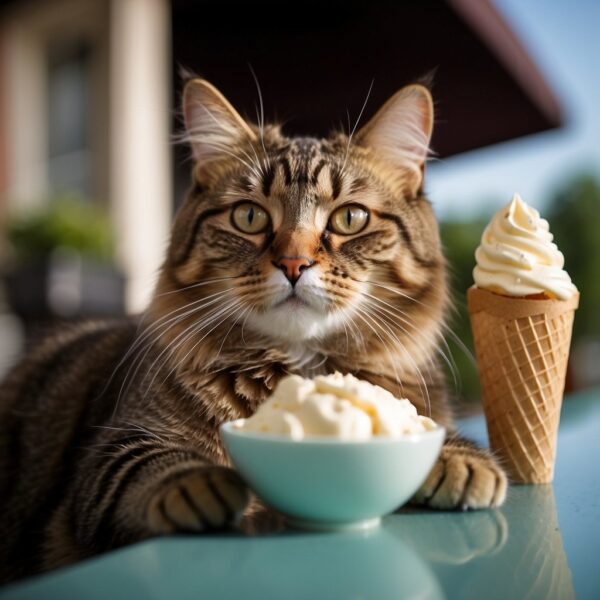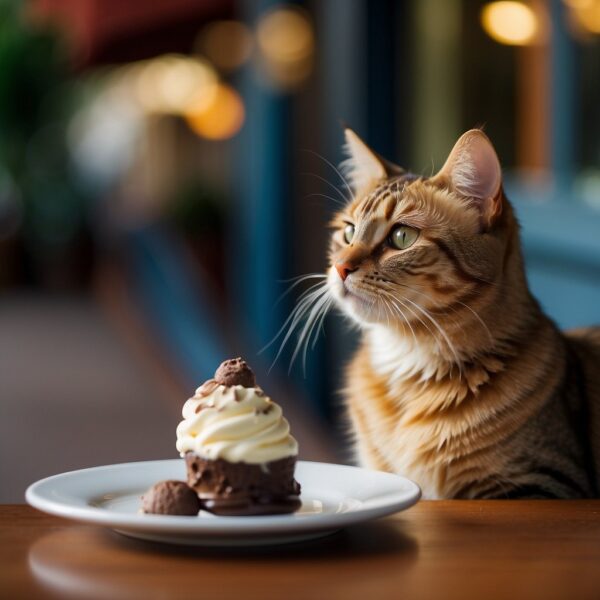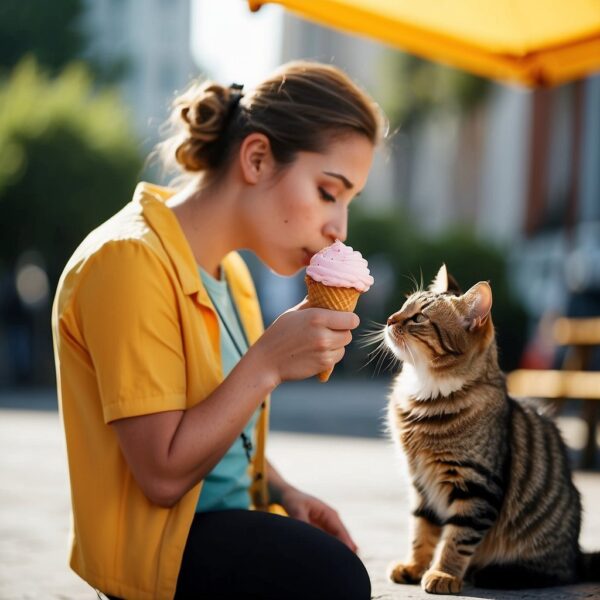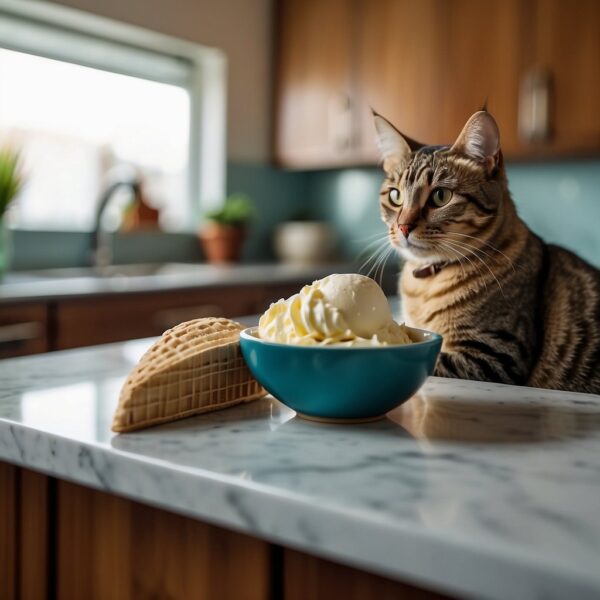
Can Cats Eat Ice Cream? the Risks and Alternatives
Cats are often intrigued by their human companions’ food, and ice cream is no exception with its creamy texture and cool temperature. It’s a common scene for a cat to be tempted by a scoop of ice cream from their guardian’s bowl, raising the question of can cats eat ice cream safely? While ice cream is not outright toxic to cats, multiple factors make it less than ideal for their dietary needs.
Cats are obligate carnivores, meaning their nutrition should primarily consist of proteins from animal sources. The majority of adult cats also lack enough lactase, the enzyme that breaks down lactose, making them lactose intolerant. Ice cream, generally rich in dairy and sugar, can lead to digestive upset in cats. Furthermore, some flavors and additives found in ice cream can be harmful to cats, with chocolate being notably toxic.
Key Takeaways
- Ice cream is not toxic to cats but is not recommended due to lactose intolerance and inappropriate nutritional content.
- Lactose intolerance in most adult cats can lead to digestive problems if they consume ice cream.
- Certain ingredients and additives in ice cream, such as chocolate, can be harmful to cats.
Understanding Feline Nutrition
Cats have specific dietary requirements that must be met to maintain optimal health. Their unique digestive systems and nutritional needs highlight the importance of a diet formulated specifically for their species.
Obligate Carnivores and Diet
Cats are obligate carnivores, which means they require a diet that is primarily made up of animal protein. Unlike omnivores or herbivores, cats have evolved to get their essential nutrients from animal sources. They have a limited ability to digest carbohydrates and derive little to no nutritional benefits from plant-based foods.
Essential Nutrients for Cats:
- Animal Proteins: Provide amino acids crucial for muscle development and maintenance
- Fats: Supply energy and help in absorbing fat-soluble vitamins
- Vitamins and Minerals: Required for a multitude of biochemical processes
Protein and Fat in Feline Diets
Protein is the cornerstone of a feline diet and should be the most abundant component in their food. It supports tissue repair, muscle maintenance, and a multitude of metabolic functions. Cats also need a moderate level of fat in their diets, which provides concentrated energy and is essential for the absorption of certain vitamins.
- High-Protein Diets: Help maintain a healthy weight and lean body mass.
- Balanced Fat Intake: Supports skin and coat health, and enhances palatability.
Carbohydrates and Cat Food
While cats have a minimal requirement for carbohydrates, some cat foods include them as a source of energy and to provide structure to kibble. However, it is crucial that carbs do not displace the essential animal proteins in their diet. The overconsumption of carbohydrates can lead to weight gain and other health issues.
- Limited Carbs: Necessary to preempt obesity and related health concerns.
- Source of Carbs: Should be easily digestible, with a preference for those naturally occurring in animal tissues.
By understanding the role of protein, fat, and carbohydrates in feline nutrition, cat parents can make informed choices about their cat’s diet, ensuring that it meets the cat’s obligate carnivorous needs.

The Truth About Cats and Dairy
Despite popular belief, cats often have a limited tolerance for dairy products, which can lead to discomfort and digestive issues.
Lactose Intolerance in Cats
Most adult cats are lactose intolerant because they lack sufficient levels of lactase, the enzyme needed to properly digest lactose found in milk. Lactose intolerance in cats can manifest as diarrhea, vomiting, and gas. It is a result of their digestive system’s inability to break down the lactose present in the dairy.
Is Milk Safe for Cats?
Milk and dairy products, including cheese and ice cream, while not toxic, are not recommended for cats due to the risk of lactose intolerance. While kittens have the enzyme in abundance to allow them to digest their mother’s milk, the production of lactase decreases as they wean and age, making most adult cats intolerant to lactose found in cow’s milk and dairy products.
cats eating Ice Cream Ingredients and Cat Health
In consideration of feline health, it is crucial to understand how certain common ice cream ingredients can impact cats. These include various sugars, potential toxic additives, and lactose content.
Sugar and Alternative Sweeteners
Ice cream typically has a high sugar content, which is harmful to cats as they do not require sugar in their diet. Artificial sweeteners, like xylitol, are even more dangerous as they may lead to rapid insulin release and hypoglycemia in cats, potentially causing vomiting and liver failure. Cat parents should always check ingredient labels for these sweeteners.
Toxic Ingredients to Avoid
Several ingredients commonly found in ice cream can be toxic to cats. Flavors like chocolate and additives such as caffeine must be avoided due to their harmful effects on cats. Even benign-seeming flavors, such as vanilla, may contain alcohol-based extracts, which are not suitable for cats.
Non-Dairy and Low-Lactose Options
While non-dairy ice cream is often marketed as a lactose-free alternative suitable for lactose-intolerant individuals, this does not automatically make it safe for cats. Cats may still react poorly to the artificial sweeteners and additives found in dairy-free ice creams. However, if a product is free from harmful sweeteners and toxic ingredients, it may be a safer occasional treat for cats.

The Impact of Ice Cream on Cat Health
Ice cream can be detrimental to cats, potentially leading to weight gain, gastrointestinal issues, allergenic reactions, and other serious health risks. Cats’ nutritional needs are far different from humans, and ice cream should not replace complete, balanced feline nutrition.
Weight Gain and Obesity
Cats consuming ice cream intake excess calories that can lead to obesity. A typical ½ cup serving of ice cream holds about 125-150 calories, significant against a cat’s daily requirement of 200-350 calories. Obesity in cats increases the risk of diabetes, heart disease, and joint problems.
Gastrointestinal Issues from Ice Cream
Most adult cats are lactose intolerant, lacking the enzyme necessary to digest lactose found in milk-based products like ice cream. This intolerance can lead to diarrhea, vomiting, gas, and abdominal pain. Chronic gastrointestinal issues can sometimes evolve into more severe conditions like pancreatitis.
Potential Allergenic Reactions
Ingredients in ice cream may trigger allergenic reactions in cats. Cats may suffer from itchiness, swelling, and other discomforts due to ingredients that they cannot tolerate well. Cats with known food allergies should avoid ice cream to prevent these reactions.
Serious Health Risks
Some ice cream flavors contain ingredients toxic to cats, such as chocolate and artificial sweeteners like xylitol. Even small amounts of these can be very harmful and potentially lead to life-threatening conditions. Moreover, repeated exposure to high sugar and fat content can contribute to longer-term health issues.
Treats Versus Complete Nutrition
While it may be tempting to offer cats ice cream as a treat, it is crucial to consider its nutritional value, which is minimal at best. Commercial cat treats are specifically formulated to be safer and healthier for cats, complementing a balanced diet without imposing the risks associated with human foods.
Can Cats Eat Ice Cream?
Ice cream is not an appropriate treat for cats due to their lactose intolerance and the potential presence of toxic ingredients. While a small amount may not cause immediate harm, there are significant health risks involved with feeding ice cream to cats.
Effects of an Occasional Lick of Ice Cream
Cats that eat ice cream may experience digestive discomfort such as diarrhea or vomiting due to lactose intolerance. Regular consumption can contribute to diabetes or weight gain since ice cream is calorie-dense and full of empty calories. While a single lick of vanilla ice cream may not result in severe illness, ice cream flavors containing chocolate, coffee, or xylitol (a common sugar-free sweetener) are toxic to cats.
Choosing Safe Treats for Your Cat
To prevent health issues, opt for cat-friendly ice cream alternatives made with non-dairy bases like oat milk or nut milk. Consult with a veterinarian before introducing new treats into your cat’s diet, especially those marketed as safe for pets but still containing high-fat content or additives.
- Safe treat alternatives include:
- Small pieces of cooked meat (like chicken or turkey)
- Commercial cat treats designed for their dietary needs
Always prioritize your cat’s health and well-being, avoiding human foods that can cause upset stomachs or worse. When in doubt about any treat, prevention is the best approach — stick to what they thrive on, which is a diet formulated specifically for felines.
Homemade Cat-Friendly Treat Recipes
Creating homemade treats for cats can be a delightful way to provide them with snacks that are safe and have some nutritional value. It’s important to choose ingredients that are non-toxic and suit feline dietary needs.
DIY Non-Dairy Ice Cream for Cats
Cats often enjoy the creaminess of ice cream, but dairy can upset their digestive system. A DIY non-dairy ice cream for cats can be made using ingredients like ripe bananas and lactose-free milk or a dairy-free milk substitute. Simply blend the banana with a small amount of milk substitute until smooth, then freeze the mixture in small ice cube trays for a convenient serving size.
Frozen Broth Cubes
Frozen broth cubes offer a hydrating and delightful treat. One can use either homemade or store-bought broth, ensuring it’s low in sodium and onion-free, as onions are toxic to cats. Pour the broth into an ice cube tray and freeze. Serving these cubes can help increase fluid intake, especially in cats that are reluctant drinkers.
Tuna Pops
Tuna pops are a quick and straightforward treat that provides both taste and hydration. Mix canned tuna in water (avoiding tuna in oil or with added salt) with a bit of water or fish stock. Pour this mixture into ice cube trays or small cups and place a catnip stick as a handle before freezing. They’re packed with flavorful fish, which cats find irresistible, but should be given in moderation due to the high protein content.

Frequently Asked Questions
In addressing common concerns about cats and ice cream, it’s essential to understand that cats are generally lactose intolerant and certain ingredients found in ice cream can be harmful to them.
Is it safe for cats to consume any type of ice cream?
No types of ice cream are considered safe for cats to consume. Adult cats have decreased levels of lactase, the enzyme needed to digest lactose, leading to potential digestive upset.
What are the potential risks of feeding ice cream to cats?
The main risks include digestive issues like diarrhea and vomiting, obesity due to high sugar and fat content, and potential toxicity from certain ingredients such as chocolate or artificial sweeteners like xylitol.
Are there any ice cream flavors that are safe for cats?
Even though some flavors may be less harmful than others, no ice cream flavors are recommended for cats due to their lactose intolerance and the general presence of sugar and unhealthy fats.
How can ice cream affect a cat’s health?
Ice cream can lead to gastrointestinal upset in cats because of lactose intolerance. Additionally, excessive sugar and fat can contribute to obesity and related health issues like diabetes.
Are there any alternatives to ice cream for cats?
As healthier alternatives, pet owners can offer cat-safe frozen treats made with ingredients like pureed pumpkin or catnip, which do not contain lactose or harmful additives.
What should I do if my cat has ingested ice cream?
If a cat ingests ice cream, monitoring for signs of gastrointestinal distress is important. If adverse reactions occur or if toxic ingredients were present in the ice cream, contact a veterinarian immediately.